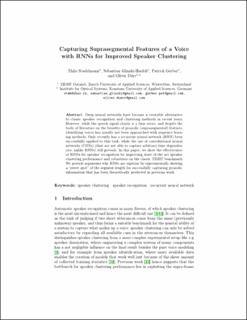Please use this identifier to cite or link to this item:
https://doi.org/10.21256/zhaw-3784| Publication type: | Conference paper |
| Type of review: | Peer review (publication) |
| Title: | Capturing suprasegmental features of a voice with RNNs for improved speaker clustering |
| Authors: | Stadelmann, Thilo Glinski-Haefeli, Sebastian Gerber, Patrick Dürr, Oliver |
| DOI: | 10.1007/978-3-319-99978-4_26 10.21256/zhaw-3784 |
| Proceedings: | Artificial Neural Networks in Pattern Recognition |
| Page(s): | 333 |
| Pages to: | 345 |
| Conference details: | 8th IAPR TC3 Workshop on Artificial Neural Networks in Pattern Recognition (ANNPR), Siena, Italy, 19-21 September 2018 |
| Issue Date: | 2018 |
| Series: | Lecture Notes in Computer Science |
| Series volume: | 11081 |
| Publisher / Ed. Institution: | Springer |
| ISBN: | 978-3-319-99977-7 978-3-319-99978-4 |
| Language: | English |
| Subjects: | Speaker clustering; Speaker recognition; Recurrent neural network |
| Subject (DDC): | 006: Special computer methods |
| Abstract: | Deep neural networks have become a veritable alternative to classic speaker recognition and clustering methods in recent years. However, while the speech signal clearly is a time series, and despite the body of literature on the benefits of prosodic (suprasegmental) features, identifying voices has usually not been approached with sequence learning methods. Only recently has a recurrent neural network (RNN) been successfully applied to this task, while the use of convolutional neural networks (CNNs) (that are not able to capture arbitrary time dependencies, unlike RNNs) still prevails. In this paper, we show the effectiveness of RNNs for speaker recognition by improving state of the art speaker clustering performance and robustness on the classic TIMIT benchmark. We provide arguments why RNNs are superior by experimentally showing a “sweet spot” of the segment length for successfully capturing prosodic information that has been theoretically predicted in previous work. |
| URI: | https://digitalcollection.zhaw.ch/handle/11475/7429 |
| Fulltext version: | Accepted version |
| License (according to publishing contract): | Licence according to publishing contract |
| Departement: | School of Engineering |
| Organisational Unit: | Institute of Computer Science (InIT) |
| Appears in collections: | Publikationen School of Engineering |
Files in This Item:
| File | Description | Size | Format | |
|---|---|---|---|---|
| ANNPR_2018b.pdf | Accepted Version | 692.47 kB | Adobe PDF |  View/Open |
Show full item record
Stadelmann, T., Glinski-Haefeli, S., Gerber, P., & Dürr, O. (2018). Capturing suprasegmental features of a voice with RNNs for improved speaker clustering [Conference paper]. Artificial Neural Networks in Pattern Recognition, 333–345. https://doi.org/10.1007/978-3-319-99978-4_26
Stadelmann, T. et al. (2018) ‘Capturing suprasegmental features of a voice with RNNs for improved speaker clustering’, in Artificial Neural Networks in Pattern Recognition. Springer, pp. 333–345. Available at: https://doi.org/10.1007/978-3-319-99978-4_26.
T. Stadelmann, S. Glinski-Haefeli, P. Gerber, and O. Dürr, “Capturing suprasegmental features of a voice with RNNs for improved speaker clustering,” in Artificial Neural Networks in Pattern Recognition, 2018, pp. 333–345. doi: 10.1007/978-3-319-99978-4_26.
STADELMANN, Thilo, Sebastian GLINSKI-HAEFELI, Patrick GERBER und Oliver DÜRR, 2018. Capturing suprasegmental features of a voice with RNNs for improved speaker clustering. In: Artificial Neural Networks in Pattern Recognition. Conference paper. Springer. 2018. S. 333–345. ISBN 978-3-319-99977-7
Stadelmann, Thilo, Sebastian Glinski-Haefeli, Patrick Gerber, and Oliver Dürr. 2018. “Capturing Suprasegmental Features of a Voice with RNNs for Improved Speaker Clustering.” Conference paper. In Artificial Neural Networks in Pattern Recognition, 333–45. Springer. https://doi.org/10.1007/978-3-319-99978-4_26.
Stadelmann, Thilo, et al. “Capturing Suprasegmental Features of a Voice with RNNs for Improved Speaker Clustering.” Artificial Neural Networks in Pattern Recognition, Springer, 2018, pp. 333–45, https://doi.org/10.1007/978-3-319-99978-4_26.
Items in DSpace are protected by copyright, with all rights reserved, unless otherwise indicated.